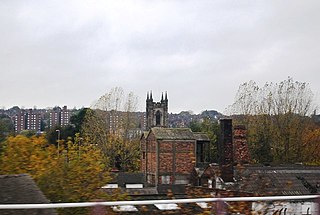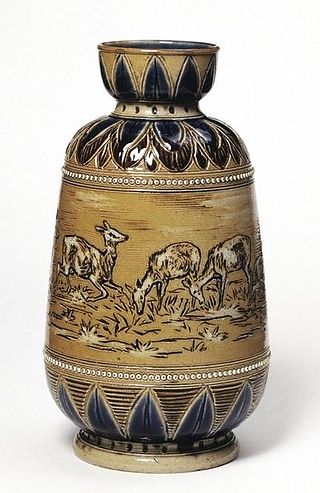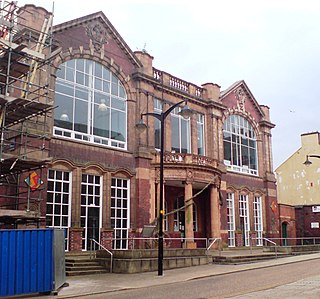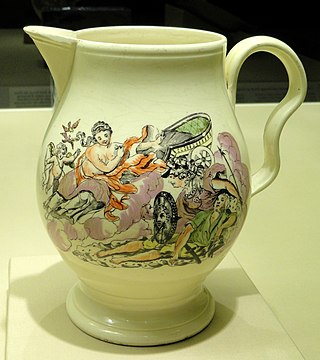
Stoke-on-Trent is a city and unitary authority area in Staffordshire, England, with an area of 36 square miles (93 km2). In 2022, the city had an estimated population of 259,965. It is the largest settlement in Staffordshire and is surrounded by the towns of Newcastle-under-Lyme, Alsager, Kidsgrove and Biddulph, which form a conurbation around the city.

Susan Vera Cooper OBE was a prolific English ceramic designer working in the Stoke-on-Trent pottery industries from the 1920s to the 1980s.

Staffordshire University is a public research university in Staffordshire, England. It has one main campus based in the city of Stoke-on-Trent and four other campuses; in Stafford, Lichfield, Shrewsbury and London.

The Staffordshire Potteries is the industrial area encompassing the six towns Burslem, Fenton, Hanley, Longton, Stoke and Tunstall, which is now the city of Stoke-on-Trent in Staffordshire, England. North Staffordshire became a centre of ceramic production in the early 17th century, due to the local availability of clay, salt, lead and coal.

Burslem is one of the six towns that along with Hanley, Tunstall, Fenton, Longton and Stoke-upon-Trent form part of the city of Stoke-on-Trent in Staffordshire, England. It is often referred to as the "mother town" of Stoke on Trent. The population of the town was included under the Burslem Central ward and had a population of 6,490 in the 2021 Census.

Bone china is a type of vitreous, translucent pottery, the raw materials for which include bone ash, feldspathic material and kaolin. It has been defined as "ware with a translucent body" containing a minimum of 30% of phosphate derived from calcined animal bone or calcium phosphate. Bone china is amongst the strongest of whiteware ceramics, and is known for its high levels of whiteness and translucency. Its high strength allows it to be produced in thinner cross-sections than other types of whiteware. Like stoneware, it is vitrified, but is translucent due to differing mineral properties.

Tunstall is one of the six towns that, along with Burslem, Longton, Fenton, Hanley and Stoke-upon-Trent, amalgamated to form the City of Stoke-on-Trent in Staffordshire, England. It was one of the original six towns that federated to form the city. Tunstall is the most northern, and fourth largest town of the Potteries. It is situated in the very northwest of the city borough, with its north and west boundaries being the city limit. It stands on a ridge of land between Fowlea Brook to the west and Scotia Brook to the east, surrounded by old tile-making and brick-making sites, some of which date back to the Middle Ages.

Charlotte Rhead was an English ceramics designer active in the 1920s and the 1930s in the Potteries area of Staffordshire.
Portmeirion is a British pottery company based in Stoke-on-Trent, England. They specialise in earthenware tableware.

Royal Doulton is an English ceramic and home accessories manufacturer that was founded in 1815. Operating originally in Vauxhall, London, and later moving to Lambeth, in 1882 it opened a factory in Burslem, Stoke-on-Trent, in the centre of English pottery. From the start, the backbone of the business was a wide range of utilitarian wares, mostly stonewares, including storage jars, tankards and the like, and later extending to drain pipes, lavatories, water filters, electrical porcelain and other technical ceramics. From 1853 to 1901, its wares were marked Doulton & Co., then from 1901, when a royal warrant was given, Royal Doulton.
The Stoke-on-Trent Regional College of Art was one of three colleges that were merged in 1971 to form North Staffordshire Polytechnic. The College of Art achieved Regional Art College status after the Second World War, but its roots lay in the nineteenth century as it was formed from three of the Potteries´ art schools.

Burslem School of Art was an art school in the centre of the town of Burslem in the Potteries district of England. Students from the school played an important role in the local pottery industry. Pottery was made on the site of the school from the early Middle Ages. The venue was refurbished and re-opened for the arts in 1999.

Mintons was a major company in Staffordshire pottery, "Europe's leading ceramic factory during the Victorian era", an independent business from 1793 to 1968. It was a leader in ceramic design, working in a number of different ceramic bodies, decorative techniques, and "a glorious pot-pourri of styles - Rococo shapes with Oriental motifs, Classical shapes with Medieval designs and Art Nouveau borders were among the many wonderful concoctions". As well as pottery vessels and sculptures, the firm was a leading manufacturer of tiles and other architectural ceramics, producing work for both the Houses of Parliament and United States Capitol.
Lorna Bailey is an English potter and businesswoman.

Art pottery is a term for pottery with artistic aspirations, made in relatively small quantities, mostly between about 1870 and 1930. Typically, sets of the usual tableware items are excluded from the term; instead the objects produced are mostly decorative vessels such as vases, jugs, bowls and the like which are sold singly. The term originated in the later 19th century, and is usually used only for pottery produced from that period onwards. It tends to be used for ceramics produced in factory conditions, but in relatively small quantities, using skilled workers, with at the least close supervision by a designer or some sort of artistic director. Studio pottery is a step up, supposed to be produced in even smaller quantities, with the hands-on participation of an artist-potter, who often performs all or most of the production stages. But the use of both terms can be elastic. Ceramic art is often a much wider term, covering all pottery that comes within the scope of art history, but "ceramic artist" is often used for hands-on artist potters in studio pottery.

Emma Bridgewater is a British ceramics manufacturing company founded in 1985. The company specialises in earthenware tableware, manufactured in Stoke-on-Trent, England. The pottery is produced using traditional techniques. The company is one of the largest pottery manufacturers based entirely in the UK.
Gordon Mitchell Forsyth (1879–1952) was a Scottish ceramic designer and fine artist and art education innovator.

Franciscan Ceramics are ceramic tableware and tile products produced by Gladding, McBean & Co. in Los Angeles, California, US from 1934 to 1962, International Pipe and Ceramics (Interpace) from 1962 to 1979, and Wedgwood from 1979 to 1983. Wedgwood closed the Los Angeles plant, and moved the production of dinnerware to England in 1983. Waterford Glass Group plc purchased Wedgwood in 1986, becoming Waterford Wedgwood. KPS Capital Partners acquired all of the holdings of Waterford Wedgwood in 2009. The Franciscan brand became part of a group of companies known as WWRD, an acronym for "Wedgwood Waterford Royal Doulton." WWRD continues to produce the Franciscan patterns Desert Rose and Apple.

California pottery includes industrial, commercial, and decorative pottery produced in the Northern California and Southern California regions of the U.S. state of California. Production includes brick, sewer pipe, architectural terra cotta, tile, garden ware, tableware, kitchenware, art ware, figurines, giftware, and ceramics for industrial use. Ceramics include terra cotta, earthenware, porcelain, and stoneware products.

William Greatbatch was a noted potter at Fenton, Staffordshire, from the mid-eighteenth to the beginning of the nineteenth centuries. Fenton was one of the six towns of the Staffordshire Potteries, which were joined in the early 20th century to become the city of Stoke-on-Trent in Staffordshire, England.















